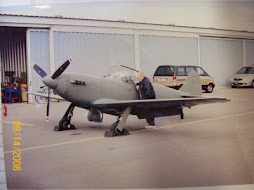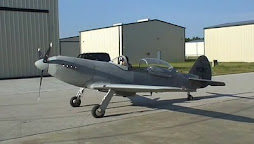Well, this post is dedicated to only one thing - the Prowler CNC Plasma system. The past 2 weeks has been one last, large effort to get this system up and running and we're happy to report that it is - FINALLY!
Here's the report:
The first step in the last big push to get the system running was to get our shop compressed air up to par. Plasma torches use a fair amount of air and it needs to be clean and DRY! The old compressor didn't have the capacity to keep up the the almost 8 CFM of air required to of the PowerMax 1000 torch. A friend recently upgraded to a new larger compressor and we purchased his gently used unit. This machine stores 80 GAL of air and can provide 17.5 SCFM continuously @90PSI. More than enough to supply the current Prowler Shop.
 Once the unit was in position we needed to install a new regulator and plumbing to get the air directly to the torch in the most direct means possible. Here is the new piping and the tie-in to the existing manifold:
Once the unit was in position we needed to install a new regulator and plumbing to get the air directly to the torch in the most direct means possible. Here is the new piping and the tie-in to the existing manifold:  Once we got the air over to the torch area, we finished the hook-ups to the refrigerated air dryer mentioned in the previous posts. The dry, clean air is critical to getting good cut quality. Here are shots of the torch cart (with the air dryer and computer card hook ups incorporated).
Once we got the air over to the torch area, we finished the hook-ups to the refrigerated air dryer mentioned in the previous posts. The dry, clean air is critical to getting good cut quality. Here are shots of the torch cart (with the air dryer and computer card hook ups incorporated). 
 The pic above also shows the new (used) computer we had to purchase for the CNC system. The previous computer was still having a problem running the control software (Mach3) and locking up the computer frequently. So we ordered a refurbished 3 Ghz P4 machine and loaded all the software onto it. We haven't had a problem running Mach3 since. With all that in place we were ready to start doing test cuts. Here is the first test cut:
The pic above also shows the new (used) computer we had to purchase for the CNC system. The previous computer was still having a problem running the control software (Mach3) and locking up the computer frequently. So we ordered a refurbished 3 Ghz P4 machine and loaded all the software onto it. We haven't had a problem running Mach3 since. With all that in place we were ready to start doing test cuts. Here is the first test cut:  As you can see, it's not good. Lots of dross, very angular cuts, just a poor quality cut. After a while we got the cuts to improve a little, but they were still not good cuts.
As you can see, it's not good. Lots of dross, very angular cuts, just a poor quality cut. After a while we got the cuts to improve a little, but they were still not good cuts.  After several calls to Hypertherm and CandCNC we made a few tweaks and got the cuts to get a little better. But they still were not good. Something was still not right.
After several calls to Hypertherm and CandCNC we made a few tweaks and got the cuts to get a little better. But they still were not good. Something was still not right. 
 At one point, a newly installed nozzle was blown off in 10 seconds of turning the torch on. Here are some pix of the carnage happening to the torch tips. This is not normal wear. Hypertherm recommended taking the PM1000 in for service.
At one point, a newly installed nozzle was blown off in 10 seconds of turning the torch on. Here are some pix of the carnage happening to the torch tips. This is not normal wear. Hypertherm recommended taking the PM1000 in for service.  After removing the torch from the table and packing it down to the local welding shop the technician there noticed a few things about the modifications made to the hand torch that didn't seem right. He was right about one thing, and that made us go back and review the whole modification. Turns out that the biggest issue was that by mounting the brass "guts" of the hand torch in the aluminum wand (shown below); the nozzles were ultimately getting grounded through the table and essentially shorting out the torch.
After removing the torch from the table and packing it down to the local welding shop the technician there noticed a few things about the modifications made to the hand torch that didn't seem right. He was right about one thing, and that made us go back and review the whole modification. Turns out that the biggest issue was that by mounting the brass "guts" of the hand torch in the aluminum wand (shown below); the nozzles were ultimately getting grounded through the table and essentially shorting out the torch. .JPG) A few well placed rubber insulators got everything set right and we were able to start making good cuts. The part below is for the same friend that the air compressor came from. They are hooks to weld to the top of a tractor bucket. They're used for hooking up chains, straps, etc. for lifting or pulling. In any event, the torch is now able to cut 1/2" thick steel with pretty good cut quality.
A few well placed rubber insulators got everything set right and we were able to start making good cuts. The part below is for the same friend that the air compressor came from. They are hooks to weld to the top of a tractor bucket. They're used for hooking up chains, straps, etc. for lifting or pulling. In any event, the torch is now able to cut 1/2" thick steel with pretty good cut quality.  Our system does leave a small amount of angularity to the cuts on the 1/2" steel, but according to Tom of CandCNC, 1/2" steel is at the limit of the capability of a PM1000. If we wanted to get nice square cuts on this type material we'd have to upgrade to a much larger torch. But, since the thickest material we need to cut for the airplane is barely 1/4" - this system should work great for us.
Our system does leave a small amount of angularity to the cuts on the 1/2" steel, but according to Tom of CandCNC, 1/2" steel is at the limit of the capability of a PM1000. If we wanted to get nice square cuts on this type material we'd have to upgrade to a much larger torch. But, since the thickest material we need to cut for the airplane is barely 1/4" - this system should work great for us.  Here is a pic of the whole Prowler CNC plasma system:
Here is a pic of the whole Prowler CNC plasma system:  From here we must expand our plasma cutting knowledge to include using different types of nozzles, the 40Amp fine cut nozzles in particular. Also, we have to learn to cut some different types of materials for the airplane; mostly Chromoly Steel and Aluminum. We'll report on that in the New Year. We also have some interesting info for the next post on a long, lost kit that was saved from the scrap heap! Stop back again next year.
From here we must expand our plasma cutting knowledge to include using different types of nozzles, the 40Amp fine cut nozzles in particular. Also, we have to learn to cut some different types of materials for the airplane; mostly Chromoly Steel and Aluminum. We'll report on that in the New Year. We also have some interesting info for the next post on a long, lost kit that was saved from the scrap heap! Stop back again next year.Merry Christmas and Happy New Year from us here at Prowler Aviation.










.jpg)
.jpg)










 Install the completed chuck and back plate onto the lathe.
Install the completed chuck and back plate onto the lathe. 



















